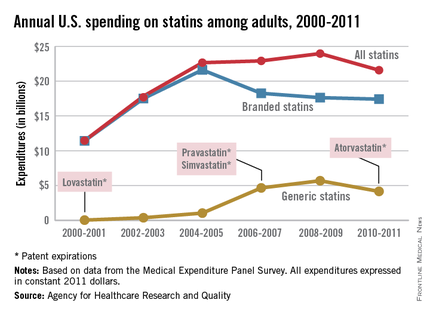Total statin spending increased dramatically from 2000 to 2005, but has plateaued since as less expensive generic statins have entered the market, according to a report from the Agency for Healthcare Research and Quality.
In 2000-2001, total statin spending was $11.5 billion, nearly all of it on branded drugs. Lovastatin, the first statin approved by the Food and Drug Administration, went generic in 2001, and by 2004-2005, generic static spending was just over $1 billion and overall spending was at $22.7 billion.
Simvastatin and pravastatin both became generic in 2006 and spending on generic statins increased by over 300% by 2010-2011 to $4.2 billion. Overall spending for statins was $21.6 billion in 2010-2011, with branded drugs representing $17.4 billion of that total, the AHRQ reported.
The number of adults taking statins rose consistently from 2000 to 2011, from 17.6 million in 2000-2001 to 40.8 million in 2010-2011, despite the use of branded statins falling from 28.6 million people in 2004-2005 to 16.6 million in 2010-2011, as generic statin use increased from 2.4 million people to 26.5 million over the same time period.
The increased use of generics brought the annual cost per user for all statins down from $762 in 2002-2003 to $529 in 2010-2011. Spending per user on branded statins, however, rose considerably over that period, going from $774 annually in 2001-2002 to $1,051 in 2010-2011. The cost of generic statins dropped from a high of $425 in 2004-2005 to $157 per user in 2010-2011, the AHRQ noted.
All data were collected by the Medical Expenditure Panel Survey.


